A Thousand Mothers Set into the Earth: It’s Garlic Planting Season…
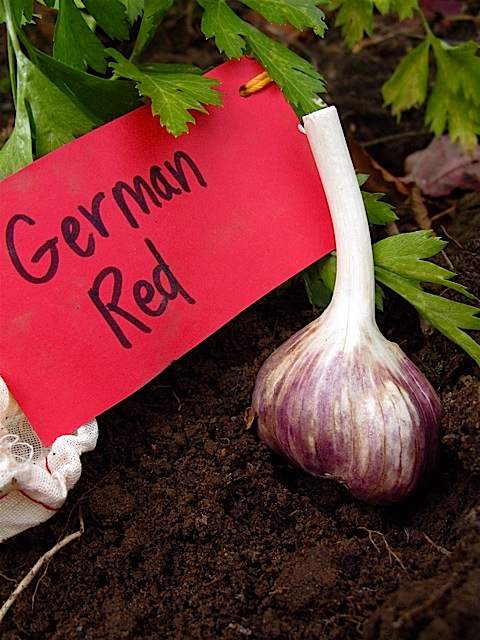 ‘German Red ‘ garlic bulb from Wild Shepherd Farm, Athens, Vermont
‘German Red ‘ garlic bulb from Wild Shepherd Farm, Athens, Vermont
The ancient Greeks and Romans often called garlic the ‘stinking rose’, and in eastern Europe it is sometimes referred to as the ‘Russian penicillin’. Allium sativium has been praised for it’s worth by many as ‘better than a thousand mothers‘; blamed for bad breath, gas and indigestion, and hailed as a cure for a wide variety of ailments from warts and blood clots to bacterial infections and even cancer. Steeped dramatic folklore, garlic frequently makes an appearance in campy old vampire films as repellent for various creatures of the night, including Count Dracula himself. I sort of like that bit – maybe I will hang a braid on my door for Halloween. But beyond its fantastic ability to ward off the un-dead, for most of us, garlic is simply a delicious culinary staple we can not do without…
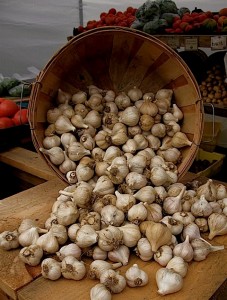 Allium sativum, ‘Music’ spills from a harvest basket in Simple Gifts Farm booth     The North Quabbin Garlic and Arts Festival
Allium sativum, ‘Music’ spills from a harvest basket in Simple Gifts Farm booth     The North Quabbin Garlic and Arts Festival
Two weeks ago I drove to western Massachusetts and spent Sunday, October 4th tasting and buying garlic, talking with local farmers, and rubbing elbows with the talented artisans at The North Quabbin Garlic & Arts Festival -Â or as the locals prefer to call it, ‘The festival that stinks’. The Garlic and Arts festival began in 1999 at the Seeds of Solidarity Farm, and is now an annual event held at Forsters Farm field every October in Orange, Massachusetts. This entertaining agricultural, food and craft fair has grown in size and scope over the past decade to become one of the most popular harvest festivals in western New England. Although I originally planned to spend both Saturday and Sunday at the event, October 3rd was something of a wash-out, so my time was somewhat limited. Next year I hope to spend two full days at the festival in order to enjoy it more fully. This year I focused mainly on the agricultural booths selling gourmet garlic, but I did connect with several New England artisans I plan to feature here in the coming months.
Autumn is garlic planting season, and I decided to plant some gourmet cultivars in my potager this fall. While at the North Quabbin festival, I spoke with two garlic growers and sampled the tasty cloves offered to visitors in their stands. My first stop was the, (North Amherst, Massachusetts based), Simple Gifts Farm booth, where the garlic was displayed in overflowing harvest baskets alongside beautiful, organically grown produce. I sidled up to the ‘Music’ garlic plate and read the informational tag:  “Music – Strong producer. Robust, minty flavor”. Mmmmm. The fragrance was pungent and indeed, the taste was slightly minty as I let the clove linger on my palate. This was described as a hardy, soft-neck garlic, (the hardneck varieties have stiff, prominent stems). I put a few bulbs in a bag and moved around the stand looking for the farmer. When I spotted him, he was busy with another customer, so I continued to sample. A jolly, conversational fellow asked if I had seen any ‘German Red’, “It’s the best” he said, “but I don’t see it here“. When the curious shopper noticed my notes, I explained my mission and he suggested I try the ‘Doc’s German’. What a find! The taste of this stiff-neck cultivar is delightfully mild and nutty, and the cloves displayed were large and golden colored. Into the bag with that tasty variety! My final purchase at the stand was recommended by the farmer, Jeremy. I asked if he had a smoky flavored garlic he could suggest for cooking. The variety I sampled, ‘Continental’, is known for retaining its true flavor in high heat. Indeed, the flavor was subtly smoky with a nice sharp finish. He did not have ‘German Red’, but suggested I check at the booth next door.
As it turned out, the next stand was occupied by Wild Shepherd Farm, based in my home state of Vermont. Athens, VT farmers Emily Amanna and David Hassan grow many gourmet varieties of garlic, but specialize in the hardy stiff-neck cultivars which they grow in their sustainable fields. I tasted many of the samples on display in their booth, including the delicious, elusive ‘German Red’ and the hardy ‘Spanish Roja’ varieties I chose to take home to my garden. ‘Spanish Roja’ is an excellent roasting garlic. Raw, the flavor is quite sharp and spicy, but once subjected to heat it mellows and deepens. I am looking forward to experimenting with it in my kitchen. ‘Spanish Roja’ also has a reputation for hardiness and good production – qualities I seek out in this cold climate and short growing season. The wildly popular, and elusive ‘German Red’ cultivar develops a rich, warm flavor when sauteed in olive oil or butter. Raw, the taste is spicy, almost on fire with classic garlic flavor. This variety has become very hard to find, and was sold out in most booths at the festival…
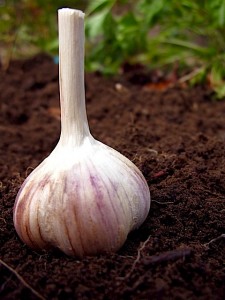 ‘Spanish Roja’ garlic bulb from Wild Shepherd Farm, Athens, Vermont
‘Spanish Roja’ garlic bulb from Wild Shepherd Farm, Athens, Vermont
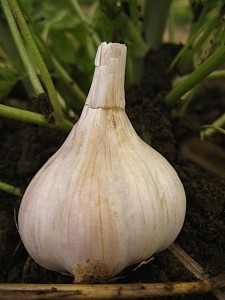 ‘Continental’ garlic bulb from Simple Gifts Farm, North Amherst, Massachusetts
‘Continental’ garlic bulb from Simple Gifts Farm, North Amherst, Massachusetts
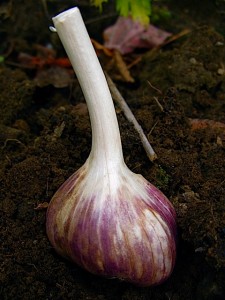 ‘German Red’ garlic bulb from Wild Shepherd Farm, Athens, Vermont
‘German Red’ garlic bulb from Wild Shepherd Farm, Athens, Vermont
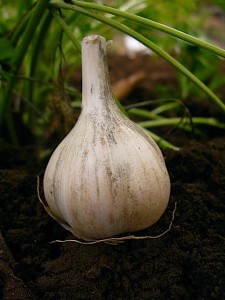 ‘Doc’s German’ garlic bulb from Simple Gifts Farm, North Amherst, Massachusetts
‘Doc’s German’ garlic bulb from Simple Gifts Farm, North Amherst, Massachusetts
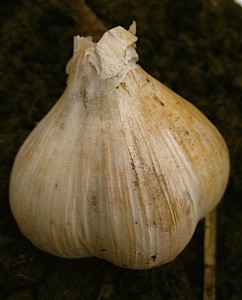 ‘Music’ garlic bulb from Simple Gifts Farm, North Amherst Massachusetts
‘Music’ garlic bulb from Simple Gifts Farm, North Amherst Massachusetts
Mid autumn is the best time to plant garlic in New England. I planted my bulbs this weekend. In warmer North American regions, garlic may be planted through early winter. Wherever you garden, it is essential to give garlic bulbs a month or two to establish before the ground freezes. Plant garlic in deep, well-drained, fertile soil, rich in organic material. Garlic produces best in full sun but many varieties will tolerate light shade. If you live in a very cold climate, ask a local grower which varieties are performing best in your region. For this reason, I believe it is wise to purchase your garlic bulbs locally whenever possible. Supporting local farmers not only feels good, it supports your overall community and makes sense for you as a gardener. Produce grown locally has been tested by your neighbors and proven successful, so it’s a good investment.
 Each Year, I Reserve Some Garlic Bulbs from the Harvest to Replant in Autumn. I Also Add New, Tasty Varieties Found at the Garlic Festival.
Each Year, I Reserve Some Garlic Bulbs from the Harvest to Replant in Autumn. I Also Add New, Tasty Varieties Found at the Garlic Festival.
Garlic bulbs should be  gently separated into cloves and planted approximately 2″ deep (that is, pointy end up, for you beginners), 6″ or so apart, and watered thoroughly. Good garlic growing companions include lettuce, herbs and beets. When planning your potager, if you practice companion planting methods, it is best to avoid positioning garlic near beans or peas. Crop rotation is always good agricultural practice, so avoid following onion crops with garlic in your vegetable plots.
 Break Firm, Good Sized Garlic Bulbs into Cloves and Plant As Described Above with Pointy End Up!
Break Firm, Good Sized Garlic Bulbs into Cloves and Plant As Described Above with Pointy End Up!
Once planted, if you live in a climate with cold winters, it is very important to mulch your garlic bulbs with straw or ground leaves to protect them from cold. This mulch will be pulled back in early spring, (usually mid-April here), and replaced with a generous layer of compost. Garlic should not be over-watered, and weeding by hand is necessary to avoid damaging the shallow bulbs. Garlic scapes (the curly tips) are traditionally removed in summer to direct energy toward bulb production. Garlic scapes are a gourmet’s delight (read more about using scapes here). Garlic Harvest tends to coincide with the maturity of onion crops here, but in case there is any doubt, look for falling tops and yellowing of the lower leaves. Pull garlic bulbs up with a garden fork and cure them for about two weeks in the sun, (or in a dry protected space like a covered porch). The method is very similar to curing onions, (see my recent post on onions here). Once dry-cured, garlic will store very well in a cool, dark, dry place for up to six months, (depending upon the variety, hard-neck garlic tends to store better than soft-neck varieties).
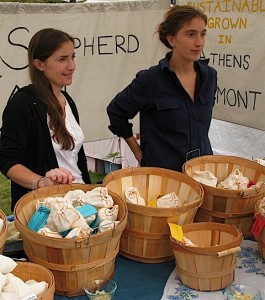 Wild Shepherd Farm tasting booth at the Garlic and Arts Festival
Wild Shepherd Farm tasting booth at the Garlic and Arts Festival
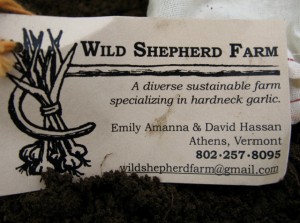 Support your community farmers – Buy your garlic locally when possible !
Support your community farmers – Buy your garlic locally when possible !
Has all of this talk about garlic left you craving the rich, nutty flavor of this delicious herb? Well then, check out this fantastic recipe for Richard Olney’s Garlic Soup, originally from The French Menu Cookbook. I just recently found it on one of my favorite food-blogs, 101 Cookbooks, and it is delicious. What perfect timing! Many thanks to the talented Heidi Swanson for her fantastic food blog and her always perfect, vegetarian recipes.
Here’s to The Thousand Mothers ! Happy planting…
Article and photographs â“’ 2009 Michaela at TGE
All content on this site, (with noted exceptions), is the property of The Gardener’s Eden and may not be used or reproduced without prior written consent. Inspired by something you see here? Great! Please give credit where credit is due. It’s a small world and link-love makes for fond friendships. Stealing makes for bad dreams…
Do you enjoy visiting The Gardener’s Eden? You can help support this site by shopping through our affiliate links. A small percentage of any sale originating from The Gardener’s Eden will go toward web hosting and maintenance costs. Thank you for your support!
3 Replies to “A Thousand Mothers Set into the Earth: It’s Garlic Planting Season…”
Comments are closed.


you can avoid indigestion by eating high fiber foods.’:.